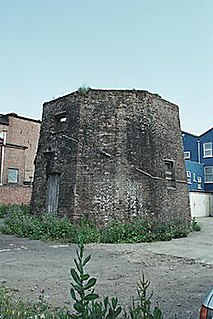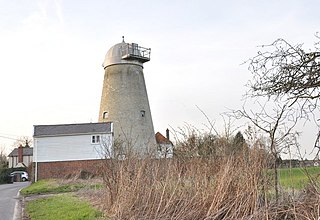
Upminster Windmill is a Grade II* listed smock mill located in Upminster in the London Borough of Havering, England. It was formerly known as Abraham's Mill and was in Essex when built. It has been restored and is a museum open to the public at selected times.

Outwood Windmill is a Grade I listed post mill in Outwood, Surrey. Built in 1665 by Thomas Budgen, a miller from Nutfield in Surrey, it is Britain's oldest working windmill.

Caston Tower Windmill is a grade II* listed tower mill at Caston, Norfolk, England which is under restoration. The mill is also a scheduled monument.

Union Mill is a Grade I listed smock mill in Cranbrook, Kent, England, which has been restored to working order. It is the tallest smock mill in the United Kingdom.

Great Mill or Ride's Mill is a Grade II listed smock mill just off the High Street in Sheerness, Kent, England, that was demolished in 1924, leaving the brick base standing. It now has a new smock tower built on it as residential accommodation.

Shiremark Mill, also known as Kingsfold Mill or Capel Mill was a listed Smock mill at Capel, Surrey, England, which was burnt down in 1972.

Baker Street Mill is a grade II listed smock mill at Baker Street, Orsett, Essex, England which has been part adapted to residential use on its lower two floors only.

Terling Windmill is a grade II listed Smock mill at Terling, Essex, England, which has been converted to residential use.

South Ockendon Windmill was a Smock mill at South Ockendon, Essex, England which collapsed on 2 November 1977.
Church End Mill is a grade II listed Tower mill at Great Dunmow, Essex, England which has been converted to residential use.

Stock Windmill is a grade II* listed tower mill at Stock, Essex, which has been restored.

White Roding Windmill is a Grade II listed preserved tower mill at White Roding, Essex, England.

Drinkstone Windmills are a pair of windmills at Drinkstone, Suffolk, England. They consist a post mill and a smock mill. The post mill is Grade I listed and the smock mill is Grade II* listed. The mills were known as Clover's Mills as they were always worked by the Clover family.

Collis Mill is a Grade II* listed smock mill at Great Thurlow, Suffolk, England which has been restored.

Thelnetham Windmill, also known as Button's Mill is a Grade II* listed tower mill constructed of brick. The windmill is located at Thelnetham, Suffolk, England. It was built in the early nineteenth century to grind wheat into flour. Thelnetham windmill worked by wind power until 1924, latterly on two sails, after which it became derelict.

Burgh Mill is a Grade II listed tower mill at Burgh, Suffolk, England which has been converted to residential accommodation.

Gazeley Mill is a tower mill at Gazeley, Suffolk, England which has been converted to residential accommodation.

Skoulding's Mill is a Grade II listed tower mill at Kelsale, Suffolk, England which has been converted to residential accommodation.

Pakenham Mill is a Grade II* listed tower mill at Pakenham, Suffolk, England which has been restored and is maintained in working order.

Buttrum's Mill or Trott's Mill is a Grade II listed tower mill at Woodbridge, Suffolk, England which has been restored to working order.





















